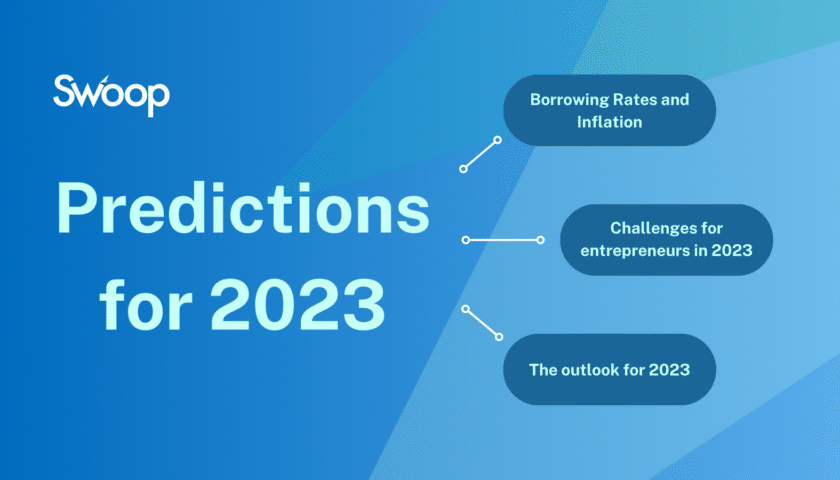AUTHOR: Daire Burke, Head of North America at Swoop
The global economy faces challenges.
The global economy is facing serious issues: the long tail of COVID-19 shutdowns, war in Ukraine and ongoing supply chain issues are all taking their toll. The coming year will see manoeuvring by governments around the world to avoid the worst of the damage.
In this article, I’m going to look at the big trends and how these will impact Canada’s manufacturing, our digital economy, and consumer spending habits. Finally, we’ll look at the challenges for entrepreneurs in the coming year.
The big picture
Canada has proven to be resilient in tackling the challenges other countries are facing. While others have it worse, there are still issues that Canadian businesses need to be aware of.
Canadian GDP growth is expected to fall below 2.0 percent during 2023. The strength of the Canadian dollar against other currencies and the increasing importance of developing the digital economy will squeeze manufacturing exports.
The federal government is expected to cut $11.6 billion from its budget this year, down from $33.9 billion in 2022–23. This will reduce the overall size of the government by 0.5 percent, the lowest level since before the 2008 financial crisis.
The CFIB small business confidence indicator registered 50.9 index points in December, which is up 0.9 points since November. While an improvement, it remains at levels usually only seen around recession periods, while the three-month outlook dropped more than three points to 40.2.
Canada’s economy has been resilient despite high inflation, rising interest rates and a declining US stock market. Growth in 2022 has been sustained by:
- A strong job market recovery
- Household savings
- High commodity prices
- An increase in business investment
- Strong demand for services unleashed after COVID-19 restrictions were lifted
The question is: can these be carried through the coming year?
Borrowing Rates and Inflation
For businesses, the cost of borrowing is going to be of high importance: businesses need funding and borrowing is a key plank in many SMEs’ financial structure.
The Bank of Canada raised its key rate by 400 basis points in 2022, and inflation has been slowing since June.
The policy rate currently stands at 4.25 percent and the first quarter will give the central bank time to see the full impact of rate rises over the past six months take effect.
Though it’s still too early to tell, signs are that the rate will stand still for the first half of the year with early indications that inflation may have peaked.
Business loans have traditionally been well above base rates, however; Canadian SMEs should look at what deals are available and look at alternative lending vehicles which may be more suitable for their needs, more resilient to changes in base rates and fit better with the overall strategy of the business.
Learn more about alternatives to unsecured loans here.
Manufacturing
Today, manufacturing contributes more than one-third of Canada’s GDP, and more than 12 million Canadian jobs are linked to manufacturing.
The sector is undergoing significant transformation. Emerging technologies and the growing importance of the digital economy will continue to challenge manufacturing’s place in the Canadian economy.
The shift toward a digital economy, supported by innovations in automation, is expected to affect jobs, wages, and business models. The growth of e-commerce will challenge industries that rely on physical stores, and new technologies such as autonomous vehicles and artificial intelligence will change the way manufacturers do business.
Businesses in this sector need to ensure that they are investing in digital approaches: these are helping early adopters find game-changing efficiencies that boost competitiveness.
Grants may be available for businesses that are seeking to accelerate their digital transformation, as well as those embarking on projects to become more sustainable.
Find out more about grants available to Canadian businesses here.
Digital Economy
Canadian businesses and governments will invest more than $50 billion in digital projects to access a growing global market in the coming years. The digital economy is projected to grow 6.4 percent during 2023. While the manufacturing sector will remain an essential part of the economy, the growth rate of the digital industry is expected to outpace the growth in the rest of the economy.
The digital economy is expected to account for a larger share of Canada’s economic output and employment. New technologies, such as machine learning and artificial intelligence, are expected to generate enormous amounts of data.
This data can improve efficiency, increase productivity, and provide new business insights.
This trend will only increase through 2023, and businesses should ensure that they are taking full advantage of the opportunities offered by this developing technology. Funding may be available for businesses seeking to invest in software as a service (SAAS) in order to reach their potential in the digital world.
Find out more about SAAS funding here.
Canadian Consumer Spending in 2023
Household spending is the main driver of growth in Canada. While consumption is usually responsible for about 60 percent of growth, it accounted for around 80 percent of GDP growth in 2022.
Higher interest rates have driven down the price of shares and houses, and that trend is expected to continue in 2023. Lower asset prices will negatively impact household spending while the post-pandemic consumer spending boom will continue to subside. All of these factors translate into a slowdown in consumer spending.
The slowdown will impact business sales and cashflow. The first quarter of the year in particular, will be critical. A significant decline in activity could force businesses to rethink their investment plans.
In any case it is essential for business owners to know which sources of funding are available to them: the worst time to start the research is when you really need the money.
A proactive approach to business finding will mean that your business borrows when it is the best time to do so – not just because there are no other choices.
Need to speak to a funding manager? Make an appointment here.
Challenges for entrepreneurs in 2023
Even if economic uncertainty remains a major concern, labour shortages are the biggest challenge for businesses. Many businesses still have staffing issues: Canada had about a million job vacancies in September and the holiday period will only have made the shortfall even more stark.
In 2023, there is unlikely to be a major change to the decade-long decline in the number of Canadian-born working age population. Immigration has been the release valve for labour market shortages, so next year should see governments and business doubling down on another policy measure: skills development.
Canada’s labour shortages may be particularly acute as a result of the pandemic, but labour market tightness will outlive the next recession. Lack of working age people and shifting skills demand with the rise of automation, green investment and other factors will lead to chronic mismatches between jobs and workers.
As the economy slows and immigration gets back on track, labour shortages are expected to subside in the short term. However, the population is ageing and there is a mismatch between the skills of available workers and the needs of industries and provinces. As a result, the labour shortage will continue to be an issue for many businesses.
Labour shortages will also affect wages, which skyrocketed in 2022 and are expected to keep growing in 2023. Wage growth may average 4 percent in 2023, well above the pre-pandemic rate of 2.7 percent. Inflation expectations also exert upward pressure on wages.
Other factors have weighed heavily on business costs over the past year. Supply chains have been affected by bottlenecks, among other things, but the pressure has eased off in 2022. Many businesses diversified their supply sources and increased storage capacity. Inventories are already starting to build up in warehouses, and businesses will have to continue to adapt to balance supply with slowing demand.
The outlook for 2023
Despite these challenges, Canadian businesses are well positioned to weather the 2023 downturn. Our surveys show that 88 percent were profitable in October, and 69 percent said they were well prepared for an economic downturn or recession.
This is not to say that complacency will be rewarded – it never is. Business owners should think carefully about what their plans are for the coming year. If they are planning to sell equity, investment for growth and profitability is essential, particularly in an increasingly digital world. They should also keep an eye on costs such as wages and energy which could derail financial plans.
Swoop is built to help Canadian SMEs access the funding they need across grants, borrowing and equity. Ensure that you have signed up to Swoop to get the best deals on a range of essential financial products – making the financial system work for you rather than the other way round. Find out more about our full range of services here.






 yet? Register here!
yet? Register here!